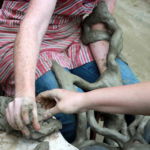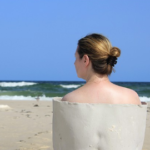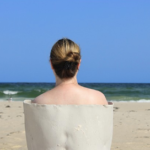Elizabeth DiDonna
Visiting Teaching Faculty Elizabeth DiDonna
Department of Art
Interview by Victoria Salgado
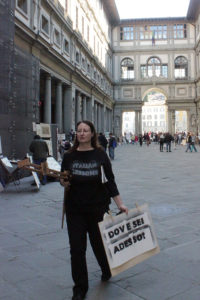 How did you begin in art?
How did you begin in art?
Art has always been there. Art has always been a part of who I was. There wasn’t a beginning place. As soon as I could start doing things with my hands, I started making stuff. I was always making stuff out of candy boxes and toilet paper rolls and anything that I could get my hands on. It never ended. There was always a continuum of art making. But knowing that I wanted to be an artist and making career decisions came much later.
What was the medium that you intended to work with as a professional artist?
When I decided to be a studio art major, I started as a painter. In my program at Wayne State University in Detroit, I had to pick a concentration. I chose painting, but I could either choose sculpture or printmaking as a second concentration. My first sculpture class was one of the experiences I had as an undergrad that changed my mind. I said, “Okay, I can’t be a painter. I need to be able to work in 3D.”
There was also a lot of performance art happening at Wayne State and in the city. There were grad students doing performance art. Artists in the community were doing performance art projects. There was a high point when I was a freshman—I was in an art history survey class. My professor, Dr. Nancy Locke, was in the middle of a lecture, and all of a sudden three people came into the room, no warning, no announcement. They were all dressed in costume. A woman wore a traditional Mexican black lace dress with a veil over her face (a mantilla). One man wore in a mariachi costume, and the other man wore jeans, t-shirt, a bandana, and dark sunglasses. He was carrying a boombox with loud music playing. They were all chained together and didn’t say a word. They walked through the classroom, up and down the aisles, then out the door. And that was it. We were like, “What the hell was that?” All Dr. Locke said was, “You just witnessed one of the most prominent performance artists today.” My jaw was on the floor. It turned out to be Guillermo Gomez-Peña. At that time, he was doing a project at the Detroit Institute of Arts, just two blocks away. That was a huge inspiration for me, so I started to do performance art pieces.
Performance art took over for a long time. When I was an undergrad, I was doing some figurative sculpture, but once I got into performance, that’s all I was doing for the remainder of my time there. There was a time gap between undergrad and grad school, where I started to work more in ceramics. I came to FSU for grad school, and that’s when I started to revisit ideas about performance. I began to do interactive, installation, and video work. Video was a natural progression for me from doing performance.
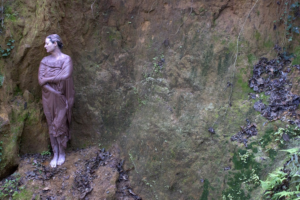 How did you branch out into those other mediums?
How did you branch out into those other mediums?
I was working in ceramics, making smaller objects that you would typically display on a pedestal. For me, when working with clay in the studio, the clay is alive and active. But when it became a fired object just sitting on a pedestal, it felt dead to me. It didn’t encapsulate my thoughts or feelings about what that material was. I felt like I had to figure out ways to explore the material through other means, so I started experimenting with photography and video, showing the viewer different aspects of the clay through all its different life forms. I would document when the clay was dug up out of the ground, what the clay was like in its wet state, how the clay changed over time and started to crack and crumble and become brittle and fragile as it dried, how it went through the process of being fired and becoming a permanent material. I was interested in telling that story about clay because just looking at the object only tells part of it. And I wanted to tell more of that narrative. To me, clay is a magic material that also has historical significance because it makes up so much of our human story. What we know about human civilization is often told through ceramic remnants that we dig up out of the ground at excavation sites. Even as my practice develops into doing more video work, I still incorporate clay most of the time in some way. It just keeps showing up over and over again as a symbolic material. For me, it symbolizes the human condition. The minerals in the earth’s crust are in the same ratio as in a ceramic vessel. We’re made up of these materials too. That fascinates me.
How do you work as an artist? Does the concept come first, or does it come about through experimentation?
It’s both. I’m not very methodical. Well, maybe I’m more methodical than I think I am. I don’t analyze it. But the ideas come, and the making comes, it’s a back and forth process. At this time in my life, I tend to spend a lot of time not making things, but reading, researching, journaling, and sketching. As ideas come to me, I write them down. A lot of the ideas that I come up with don’t ever get made, but they keep coming. I feel lucky that I’m never short of ideas. I never get artist’s block. And I’m not an artist that goes to the studio every day and works little by little. Everything usually happens in big spurts, based around a project. I spend lots of time and late nights working, working, working, working toward the end of a project. If I have too many ideas, I do the ones I’m most excited about, the ideas that make my heart race when I think about them. But I have to make decisions because I don’t have the time to make everything.
How do you balance your responsibilities as a human being, a professor, and an artist?
As best I can, I guess. It’s not easy. There was a time in between undergrad and grad school where I saved up enough money to take time off. I didn’t have a “job” for almost a year, and all I did was create in the studio. It really surprised me because I wasn’t happy. I thought I would be, but I felt lonely being in the studio all the time by myself. I realized that I had to have a balance between my solitary studio time and my time working with other people. When I spend a lot of time teaching, advising, talking, and interacting, then I get tired and depleted, and I want to get into the studio. When I’m in the studio, I feel isolated after a while, so I have to strike a balance somewhere. You need to make decisions about what’s most important. These are all things that I learned along the way: Not creating doesn’t work and creating all the time doesn’t work. It’s about finding the equilibrium between all of these things and knowing that all of them are important in their way. All you can do is try to figure out how to satisfy all of them enough because we have limited time and energy.
What are common themes throughout your work?
That’s a hard question. There’s a quote from Louise Nevelson that I love. She was a very austere woman, famous for making these installation constructions of objects. There was a documentary of her making these pieces. The interviewer was so enthralled with her process and watching her work, and he asked, “How do you make decisions about this shape or that shape and where they go? How do you make decisions about that?” She just looked at him and said, “Darling, how do you eat a pear?”
I always loved that quote from her. And it’s true. A lot of decisions are intuitive and hard to put into words. But I’m interested in memories, in histories and revealing these histories. They’re often things that are hidden, neglected, or ignored. I create physical spaces to reveal those things in some way. And I use layers. Layers are always in my work. It’s usually about a visual uncovering that stems from memory, either physical, historical, personal, or some combination of those things.
How do you know when a work is finished?
It’s intuitive and changes all the time. For me, it’s not methodical. Sometimes the work comes very quickly, and the idea I had at the beginning is what transpires. Most of the time, I have this image in my head, but when it starts to appear, it doesn’t work at all. Whatever the idea was in my head changes as I’m making it. So I keep working it and reworking it until it does work. Frequently, that feeling about whether it’s working is very visceral instead of some mental construct about whether or not it’s working. Sometimes it’s frustrating when the work continues to suck and suck and suck, but you keep working until it doesn’t suck anymore. You keep going until it makes sense to you in some way.
What would you consider your most important artistic tool?
My hands. Now I’m working more with video, so I’m doing a lot more computer-based work than I’ve ever done before, but everything still always starts with my hands. I do a lot of journaling, a lot of writing, a lot of sketching, and a lot of the thought process happens through those actions.
I have tools that I love, but I can live without them. That’s another thing that I love about clay. If the power went out for two weeks and I couldn’t make videos, I know exactly where to go, down the street, to dig up clay, make objects out of it, and fire it without any technology at all. Just the technology of… fire. [laughs] I don’t need anything other than that.
How do you negotiate the logistics of proposal writing, exhibiting, and installing with actually creating the art?
Occasionally I sell work, but that’s not my main focus. It’s mostly experimental work. I write proposals and exhibit in nonprofit and alternative spaces that support artists working this way. They’ve been mostly either solo or 2–3 person shows, where I proposed a plan for the space and the gallery accepted it. The best spaces are the ones that provide funding. That can be challenging to obtain, especially with nonprofit spaces that don’t have a lot of resources.
One of the first things I do is I look at the space, either physically or online to see what it’s like. Often, my work is site-specific and ephemeral, so I usually want to take into consideration the history or layout of the space. I try to see how well my work fits with their space. And those are the open calls that I apply to. Because the work is often ephemeral, it may only physically exist for a short time, and then is only experienced through documentation. If it was site-specific, then I have a hard time presenting that work in another space.
 Do you often collaborate?
Do you often collaborate?
Rarely. Not that I’m against collaboration—I love the idea of it. Maybe in the future, I’ll do more of it. Five years ago, I did a photo series with my partner, Brian Anthony. He’s an artist that does a lot of video, film, photography, and music. He’s a fantastic photographer. For this particular project, I had sketches and ideas about what I wanted to see, but we didn’t know exactly what we were going to get until we got out there. The Compose/Composure picture was very much orchestrated. That was one of those instances where exactly what I sketched in my sketchbook was what we did. It’s rare for that to happen. One photo happened while walking around Lake Jackson’s archeological mounds. We spend a lot of time out in nature, walking around. I would see spaces within a park and say, “Oh, that looks amazing.” For Steephead, there was a vast cliff—a wall of red dirt. It just looked like the perfect backdrop for a tableau. I said, “Okay, I want to shoot there.” We always knew the general location where we wanted to shoot, we knew that it would incorporate clay, and we knew that I was going to be in the image. But that’s all we knew going in. We made decisions about where I would stand and where the camera would be. There were also these big spiders all over the place, and I was barefoot. I had no idea if they were venomous or not, so there was some danger involved! We always shot at a particular time of day, but we had to think about how the light was hitting and things like that. But we always made decisions together.
Another one of my favorite moments was at a residency at the Watershed Center for Ceramic Arts. It was a 2-week residency, and Summer Zickefoose was leading an “artists invite other artists” involving ceramics and performance art. We were all working in the studio collaboratively and separately. I had an idea about quilting circles, where a group of women work on a quilt together, while they talk about their memories and things like that. I love that idea. So I asked Summer if she wanted to try something. We set up parameters for ourselves, especially since this project was more of a performance. We were limited to a block of clay, and decided we’re just going to keep doing something until the clay’s gone. We sat together in this dirt pathway between the studios and living spaces while another artist, Erik Scollon, documented the whole thing. We didn’t know how it was going to start, but as we began making things, we decided we were going to start building the clay on each other. And we found that the clay was becoming a limitation. It turned out that the more we built on ourselves, the less movement we had, so we ended up helping each other. In the moments when she couldn’t move, I had to build on her, and vice versa. Tons of mosquitoes bit us as we were doing this, but we just kept building and building. We created these large t
entacle-like structures connecting us. That was a great project. I would love to do more collaboration, but it’s one of those magical things. If the opportunity presents itself, I would be open to it.
How do you negotiate disconnects in objectives and ideas?
Establishing parameters, like the project at Watershed. I also think when you’re collaborating, you have to be open. Establishing what you want and anything that happens beyond or outside of that, you have to be open to. You have to let go of control when you’re collaborating with people. That’s one way to establish parameters, but I always think about an artist group called Critical Art Ensemble. When asked about their process of collaboration, they say everyone has an expertise role and total autonomy within that role. Each person has complete control over their part of the project, and that works very well for them. Ultimately, I think it depends on the collaboration, but I think it’s essential to establish what your role is within the project.
You mentioned there was a large gap between undergrad and grad school. What prompted your decision to go back to school and get your MFA?
I worked as an administrator for several years at a private school called Marygrove College in Detroit, Michigan. I taught a little bit, but I wasn’t a full-time instructor then, and I recognized that I wanted to do more of that. I wanted to interact with the students more and perform less in an administrative role.
This was during the Great Recession—Detroit was really struggling. Every semester, they looked at enrollment and if they didn’t meet their number, they started laying people off. It was very stressful. Luckily, our dean, Rose DeSloover, was a great advocate. So I decided to go back to school, and I’m so glad I did. It was the right time and the right move back.
How’d you end up at FSU?
Before I moved to Detroit, I used to live in south Florida. My father and brother still live down south, so I have family connections in Florida. When I was looking at grad schools, I found Holly Hanessian’s ceramics work. I felt an immediate connection to her and her research. And coincidentally, Holly had a Michigan connection. My mentor at the time, Jane White, was friends with Holly.
Also, I spent many, many years in Detroit, and I felt like I did what I could do. I contributed to that community, but I needed a fresh start within a new community. I thought that FSU was an excellent place to come to.
How would you describe your teaching practices?
I teach studio, but the last few years I’ve mainly been teaching professional practices. It’s less about making work and more about the other end of the spectrum—how can you turn this into a livelihood and career. Overall, I think when you’re teaching students to make art, it’s essential that students are introduced to contemporary art practices. A significant concern is that students become aware of what’s happening in the art world today.
I provide space for students to experiment and take risks, especially those in undergrad. When you’re an undergraduate, it’s important to take as many risks as you can and to experiment with as many different types of materials and processes as possible. I provide experiences and information, and flood students with as much as I can to see what clicks. Certain things are going to click for some people and not with others. Helping students find their way and voice and confidence in themselves is really important. Art students, in particular, often struggle with deciding if they’re talented enough or if they have what it takes. They often struggle with deciding to study art in the first place because there are a lot of questions about being able to find a job. There’s often pressure and judgment from family and even friends.
What drew you to academic advising?
Well, I needed a job. [laughs] I call my work my mission. It sounds very lofty, but I consider what I do a four-fold mission. I teach art, write about art, advocate for artists, and make art. They’re like the branches of a tree. One branch is to advocate for artists. This goes back to my art uncovering and showing things that are overlooked or ignored. I feel that way about people too. I’m always trying to help the underprivileged. Whoever isn’t being served are the people that I tend to gravitate towards. Being an advisor is a natural fit for me because when I hear that students are struggling or are being underserved in some way, then I want to help them. As an advisor, I see another aspect of college life. Often, if students are having a hard time academically, there are typically other things going on in their lives. I try to help them uncover resources that can help them with those aspects of their life so they can get back in the studio, make art, and not be stressed out about those other things. It’s an important role that we have here. For the four years I did it, I was happy to do so.

